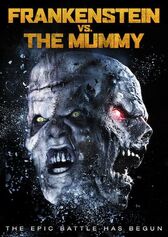
Frankenstein vs. The Mummy is an American horror film written and directed by Damien Leone. It was produced by Jesse Baget, Gary Lo Savio, Lisandro Novillo, Tony Scoughton Sr., and Neal Seidman. It was released as a DVD premiere in the United States on February 10th, 2015.
Synopsis[]
The film opens with a dimly-lit conversation between Dr. Victor Frankenstein and Carter. Victor is shown paying Carter for what appear to be body parts, and giving him a final order. In class the next day, Victor gives students in his Philosophy of Medicine class a lecture in which he quickly reveals what he believes to be the goal of medicine, and indeed the goal of human existence in general: immortality.
Major Themes[]
Knowledge - Science vs. the Supernatural []
Many Frankenstein adaptations are highly concerned with pitting science against the natural world, with the scientist attempting to take on the role of nature by giving life to dead/inanimate materials. Frankenstein vs. The Mummy touches on these issues, but also sheds light on another potential connection. While Frankenstein’s monster is a stand-in for human hubris and science taking a natural process “too far,” the mummy can be understood as a symbol of what can happen when human beings don’t show the appropriate amount of deference to forces that they do not fully understand. The battle between the monster and the mummy represents a struggle between two sides of human nature. On one side of this battle is new, scientific knowledge and the desire to know and master the body and the world. On the other side stands ancient knowledge, superstition, and magic. These forces are, like their personifications in the film, in constant conflict with one another. The battle between claims the life of Victor, who arrogantly chose to give life in an unnatural way. Likewise, Dr. Walton, the anthropologist who takes too much stock in the ancient is killed in his quest to serve the mummy. With this theme in mind, the film’s message is twofold: that arrogance in the face of powerful knowledge ends in misfortune, and that the best path for seeking knowledge is a balanced one. This is exemplified in Naihla’s character, who seeks out new knowledge but remains wary and respectful of the mummy’s curse.
Transcendence - Man vs. His Maker[]
Similarly, Frankenstein vs. The Mummy examines the essence of what it means to be human, and how that humanity can be changed by the actions that people take. Victor makes his views on medical philosophy and ethics extraordinarily clear. Victor is an atheist, and tells his class that what separates man from gods is the ability to control life. With his experiments, Victor is attempting to transcend his humanity and become what he considers a god by reanimating a corpse. Interestingly, the man/god dichotomy is also presented at various points throughout the “mummy” portion of the narrative, often in an extremely explicit manner, such as when Naihla tells her class the Egyptian pyramids were not only tombs, but places in which “men became gods,” referring to the pharaohs who, once interred in their pyramids, began the journey to the afterlife in which they would become deified. The film shows that attempts toward godhood (through magic and ritual as with Usekara, or through science as with Frankenstein and his monster) are doomed to fail.
Violence - Man vs. His Miscreation[]
Frankenstein vs. The Mummy is most certainly a horror movie, and gratuitous violence abounds. If this abundance of violence is examined as a theme in itself, it can be understood as a natural consequence of the specific violations against nature that are perpetrated in this film. It is almost as if the monster and mummy are locked in conflict because of their status as extremes on either side of the science/magic continuum, and the process of equalization results in the destruction of both.
The villains in the film cannot exist in the same world. Both are trying to realize their monstrous intentions with Naihla – the monster wants to defile her sexually and use her to get a new body, while the mummy needs her to free it from the spiritual bonds that tie it to earth. These perversions of the life/death cycle can only interact with the world and with each other through violence, since they have been robbed of the humanity that would allow them to interact normally.
Reception[]
Frankenstein vs. The Mummy was not well received among critics, nor was it popular with the public. The film was released straight to DVD. Rotten Tomatoes gives the movie a 13% rating, citing the average rating from the site’s users as 1.7 out of 5. This is not a film that garnered much attention from big name critics, even those dedicated to coverage of horror films.
Significance of Adaptation[]
This adaptation is a unique one. The movie represents a departure from the Gothic-style storytelling of the novel and many of its adaptations in favor of a jump scare and gore-centered presentation, well in line with its B-horror roots.
Still, there are connections between Frankenstein vs. The Mummy and its predecessors. One of the most obvious is the obligatory “It’s alive!” line delivered by Victor, made famous by James Whale's Frankenstein (1931). Interestingly, this movie features the monster at two levels of verbal fluency. He begins only being able to grunt, forcing out words, but by the end of the film he seems to speak better than Carter (the source of his brain) ever had while he was alive.
